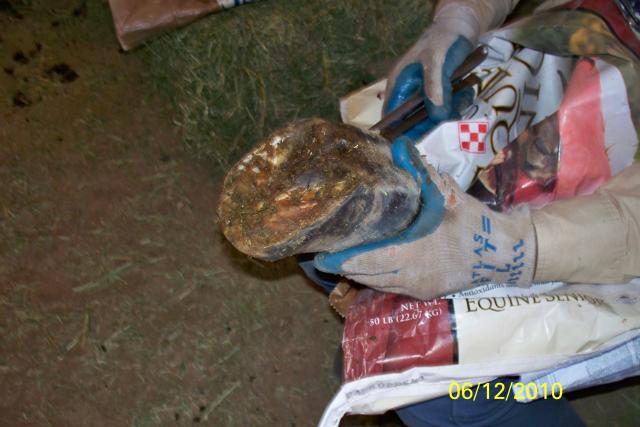I am one of the very lucky people that was able to go to Dr. Tomas Teskey’s hoof clinic and dissection in Hereford, AZ. It was a total eye-opener to me, having grown up in the generation of “shod” horses. I truly wish every horse owner had the opportunity to go to his clinic. Because that is not possible, I thought that I’d pass along excerpts from Dr. Teskey’s article called “Breaking Traditions.”

“We responsible horse stewards are taking a new interest in our horse’s feet. As a veterinarian studying the equine hoof for the past few years, I have found that most veterinarians, farriers and trainers do not know what a normal horse’s foot looks like, nor do these professionals have a full understanding of how a normal horse’s hoof functions. From pictures in veterinary references to diagrams in farrier texts, the equine foot is represented as a structure devoid of its most beautiful and functional characteristics.
The prevalence of hoof deformities in the general horse population is so common that they are looked upon and thought to be “normal ” — The picture of a narrow, upright hoof, complete with a steel shoe has permeated our modern culture so deeply that it will take decades and generations to fully expose it as the deformity and the cruelty it represents and replace it with an image of a full, round, unrestricted hoof symbolizes the horses’ strength, health and vitality. Listening to and depending on veterinarians, farriers and trainers to tell you what is right and healthy for your horses shows you respect these professionals, but because most of them are not experts regarding horse’s hooves, it is critical that you are at least able to recognize what a normal hoof looks like and know a deformed one when you see it. Only after you educate yourself in these matters, can you have an intelligent conversation with professionals and make an informed decision regarding their recommendations.
The problem actually begins before a steel shoe even touches the horse’s hoof. The preparation of a hoof for the application of a steel shoe is extremely damaging in itself. The natural, life-promoting, energetic shapes of the natural hoof are disrespected and disregarded when a farrier flattens the solar aspect of the hoof for the application of a shoe. The horse’s foot evolved as a conical structure, with a set of cones and sets of triangles collected together in a final architecture that is one of the strongest, most dynamic shapes in the universe. Flattening the bottom of the equine hoof demonstrably destroys its ability to efficiently perform all of its functions and the subsequent nailing of a rigid steel ring around its lower edges ensures a steady and treacherous progression towards disease in the entire horse.
Continuing this shoeing procedure perpetuates a state of physiologic stagnation and predictably leads to hoof deformation. For man’s application of steel to the body of the horse, this resultant stagnation and deformation leads to disease, lameness, premature loss of use, painful debilitation and eventual early death in well over half of all domesticated horses in the industrial world today.”

During Dr. Teskey’s clinic, he stated that horses should be allowed to go barefoot and that their feet should be protected with protective hoof boots and, possibly hoof pads only when necessary such as rough, rocky terrain or during transition from shoes to barefoot, stressing the need for natural hoof care. He also spoke on the subjects of natural hoof trimming, diet, natural horse care and natural hoof care products.
Dee Hoime





